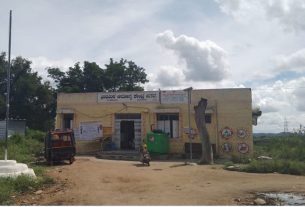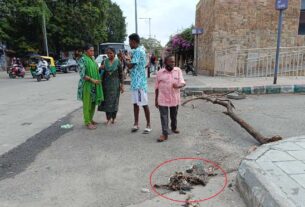Jayshree Ramesh Amagol from Sindagi has four children, of whom three had at least once suffered from typhoid, dysentery or dengue—water-borne diseases.
By Manasvi Gupta
Bengaluru: Potable water available to the villagers of Sindagi Taluk through bore wells contains bacteria like E. Coli, which makes it unsafe for drinking and cause diseases like typhoid, diarrhoea, dysentery and other allergies (especially in children).
As per the reports by The National Health Mission around two per cent of the population in Sindagi suffers from water-borne diseases. Out of 7273 cases of water-borne diseases reported during the period of the last 10 months, the most prominent are Acute Diarrheal Disease (4446 cases) followed by Typhoid (1408 cases), Bacillary dysentery (1342 cases) and Viral Hepatitis (77).
“Every second villager had suffered from diarrhoea, typhoid or jaundice at some point of their lives,” said Husen Bashhy, a villager from Sindgi TalukHe continued, “Doctors advise to avoid contaminated food and water, but this water is the only source for us.”
The Groundwater Information Booklet (GIB), Vijayapura, shows that water in the district is potable to brackish, and may contain disease-causing bacteria.
Sunil Maddin, Executive Officer of Sindagi Panchayat said, “I agree that health issues due to contaminated water do exist in the taluk. We send the water samples to labs for testing, but I haven’t received any report of this year yet.”
Chemical parameters like pH, TSS, TDS, EC, dissolved Oxygen, cations and anions, phosphates and Fluorine are present in water.
In addition, there are heavy metals, organic micropollutants and pesticides. Parameters like Fluoride, Nitrate, Total Hardness and Iron content in excess of their permissible limits also affect the health of the people.
Vijayapura District Medical Officer, Dr. Rajkumar Yaragal said that they are responsible only for testing water quality and that the Gram Panchayat is responsible for the supply of water.
As per the booklet, owing to open- defecation practices, Higher concentration (>45 mg/l) of nitrate is reported in few villages of Sindagi TalukHigher concentration of (>1.5 mg/l) of fluoride is reported at Sivanagi village in Sindagi taluk.
Mr. Maddin added, “The supply of water is a single- village project. The groundwater itself is not contaminated but the connections made in the water supply to the households by the concerned authorities or illegally by villagers themselves, induce impurities into the water and make it unfit for consumption.”
Sarojini Basavraj, Project Officer, Sindagi also agreed to the fact that villagers are prone to water-borne diseases because the bore well water they consume is full of impurities.
Only one out of five villages in Sindagi has a filter/RO plant installed. Budihal PH village has one, supplies six litres of water for one rupee—claimed by the waterman of that village.
Basavraj Mural, who has a filter installed in his village, said that it does not provide water throughout the day and people who live far face a lot of inconvenience.
He said, “People avoid walking long distances to fetch filtered water, so they continue using the bore well water available to them easily.”
Jayshree, whose village doesn’t have any filter, complaints that in spite of writing to the authorities many times, no steps have been taken.
Regarding the availability of filters in villages, Mr. Maddin said, “RO plants are very costly to install. During summers, when the region suffers from a scarcity of rainfall, we cannot fill water in RO plants and hence their membrane dries and they stop working. One has to then spend Rs 50,000 to replace the damaged plant.”
As per a report, it is essential to treat water to a desirable standard before it is supplied. Usage of galvanized iron/ PVC pipes and proper casing can help reduce some excess minerals.
GIB suggests that educating people by imparting the importance of safe drinking water in local languages, through regular village level camps, using audio-visual media, ensuring the participation of local chefs, farmers need to be undertaken.




